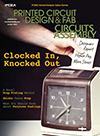Products
Symbion S36 post-reflow automated optical inspection system provides inspection for high productivity and first-pass yield. Wizard & Go operation features a user-friendly graphic wizard interface that reduces set-up time and operator requirements. DPIX detection technology, based on specialized 3-D image acquisition and image processing techniques, reportedly ensures high accuracy detection with minimized false calls and without compromising speed. Produces measurement and attribute data for statistical process control (SPC). Integrated ADVISOR software allows users real-time access to data for continual process analysis and improvement.
Orbotech Ltd., orbotech.com
Green Monster! ESD stencil wiping rolls prevent static buildup and do not use weak paper or tissue fibers. Paper or tissue is typically only held together by weak hydrogen bonds which are quickly destroyed when wet. Instead, they use thicker and coarser rayon fibers that absorb solvents.
With coarse fibers, the porosity is higher, more vacuum can be used to clean solder paste from the apertures, and they are conducive to an aggressive cleaning surface.
High-Tech Conversions, high-techconversions.com
32K443-800 connector has a four-hole flange mounting structure, with a separate center contact pin soldered to the signal via the board. The connector is reusable, extra center contact pins are available. Said to have excellent electrical performance up to 18 GHz.
SMCC (surface mount coaxial connector) products provide an impedance match if the signal trace or signal via on the board is 50 Ohm.
SMCC (surface mount coaxial connector) products provide an impedance match if the signal trace or signal via on the board is 50 Ohm.
Rosenberger provides custom footprints to its customers, developed based on the connector and board models that optimize RF performance.
Rosenberger of North America, rosenbergerna.com
Press Releases
- E-tronix Hosts Webinar with Laser Wire Solutions CEO on Advancing Medical Manufacturing Through Laser Technology
- Niche Electronics Completes Transition to Enhanced Leadership Team
- Aegis Software Expands its Presence in France and Partners with STPGroup
- Altus Adds Breakthrough Automated Inline Laser Depaneling System to its Line-Up


